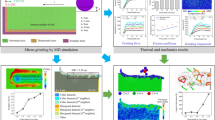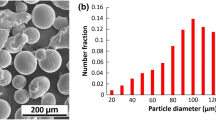Abstract
Nanocutting mechanism of single crystal 6H-SiC is investigated through a novel scanning electron microscope setup in this paper. Various undeformed chip thicknesses on (0001) < 1–100 > orientation are adopted in the nanocutting experiments. Phase transformation and dislocation activities involved in the 6H-SiC nanocutting process are also characterized and analyzed. Two methods of stress-assisted and ion implant-assisted nanocutting are studied to improve 6H-SiC ductile machining ability. Results show that stress-assisted method can effectively decrease the hydrostatic stress and help to activate dislocation motion and ductile machining; ion implant-induced damages are helpful to improve the ductile machining ability from MD simulation and continuous nanocutting experiments under the online observation platform.


















Similar content being viewed by others
Abbreviations
- SiC:
-
silicon carbide
- SEM:
-
scanning electron microscope
- EBSD:
-
electron backscatter diffraction
- FIB:
-
focused ion beam
- ABOP:
-
analytical bond order potential
- DXA:
-
dislocation extraction algorithm
- SRIM:
-
Stopping and Range of Ions in Matter
- MD:
-
molecular dynamics
References
Khuat V, Ma Y, Si J, Chen T, Chen F, Hou X (2014) Fabrication of through holes in silicon carbide using femtosecond laser irradiation and acid etching. Appl Surf Sci 289:529–532
Zhang Z, Cui J, Wang B, Jiang H, Chen G, Yu J (2018) In situ TEM observation of rebonding on fractured silicon carbide. Nanoscale 10:6261–6769
Cui J, Zhang Z, Jiang H, Jiang H, Zou L, Guo X, Yao L, Ivan PP, Guo D (2019b) Ultrahigh recovery of fracture strength on mismatched fractured amorphous surfaces of silicon carbide. ACS Nano 13:7483–7492
Mélinon P, Masenelli B, Tournus F, Perez A (2007) Playing with carbon and silicon at the nanoscale. Nat Mater 6:479–490
Guo X, Li Q, Liu T, Kang R, Jin Z, Guo D (2017) Advances in molecular dynamics simulation of ultra-precision machining of hard and brittle materials. Front Mech Eng 12:89–98
Eker S, Durandurdu M (2009) Pressure-induced phase transformation of 4H-SiC: an ab initio constant-pressure study. Europhys Lett 87:36001
Loan PRV (1967) A study of polytypism in silicon carbide. The American Mineralogist 52:946–956
Fang FZ, VenkateshV C (1998) Diamond cutting of silicon with nanometric finish. CIRP Annals-Manufacturing Technology 47:45–49
Fang F. Z., Wu H., Zhou W., Hu X. T (2007) A study on mechanism of nano-cutting single crystal silicon. J Mater Process Technol 184:407–410
Lai M, Zhang X, Fang F, Wang Y, Feng M (2013) Study on nanometric cutting of germanium by molecular dynamics simulation. Nanoscale Res Lett 8:13
Fang F, Xu F, Lai M (2015) Size effect in material removal by cutting at nano scale. Int J Adv Manuf Technol 80:591–598
Li Z, Zhang X (2017) Subsurface deformation of germanium in ultra-precision cutting: characterization of micro-Raman spectroscopy. Int J Adv Manuf Technol 91(1–4):213–225
Zhang ZY, Huo YX, Guo DM (2013) A model for nanogrinding based on direct evidence of ground chips of silicon wafers. Science China-Technological Sciences 56(9):2099–2108
Zhang Z, Song Y, Xu C, Guo D (2012) A novel model for undeformed nanometer chips of soft-brittle HgCdTe films induced by ultrafine diamond grits. Scr Mater 67(2):197–200
Zhang Z, Huo F, Zhang X, Guo D (2012) Fabrication and size prediction of crystalline nanoparticles of silicon induced by nanogrinding with ultrafine diamond grits. Scr Mater 67(7–8):657–660
Zhang Z, Wang B, Kang R, Zhang B, Guo D (2015) Changes in surface layer of silicon wafers from diamond scratching. CIRP Ann 64:349–352
Zhang Z, Guo D, Wang B, Kang R, Zhang B (2015) A novel approach of high speed scratching on silicon wafers at nanoscale depths of cut. Sci Rep 5:16395
Wang B, Zhang Z, Chang K, Cui J, Rosenkranz A, Yu J, Guo D (2018) New deformation-induced nanostructure in silicon. Nano Lett 18:4611–4617
Zhang Z, Du Y, Wang B, Wang Z, Kang R, Guo D (2017) Nanoscale wear layers on silicon wafers induced by mechanical chemical grinding. Tribol Lett 65:132
Zhang Z, Cui J, Wang B, Wang Z, Kang R, Guo D (2017) A novel approach of mechanical chemical grinding. J Alloys Compd 72:6514–6524
Patten J, Gao W, Yasuto K (2005) Ductile regime nanomachining of single-crystal silicon carbide. J Manuf Sci Eng 127:522–532
Wu ZH, Liu WD, Zhang LC (2017) Revealing the deformation mechanisms of 6H-silicon carbide under nano-cutting. Comput Mater Sci 137:282–288
Meng BB, Zhang Y, Zhang FH (2016) Material removal mechanism of 6H-SiC studied by nanoscratching with Berkovich indenter. Applied Physics A 122:247
Zhang F, Meng B, Geng Y, Zhang Y (2016) Study on the machined depth when nanoscratching on 6H-SiC using Berkovich indenter: Modelling and experimental study. Appl Surf Sci 368:449–455
Li Z, Zhang F, Luo X (2018) Subsurface damages beneath fracture pits of reaction-bonded silicon carbide after ultra-precision grinding. Appl Surf Sci 448:341–350
Goel S, Luo XC, Comley P, Reuben RL, Cox A (2013) Brittle-ductile transition during diamond turning of single crystal silicon carbide. Int J Mach Tool Manu 65:15–21
Xiao GB, To S, Zhang GQ (2015) The mechanism of ductile deformation in ductile regime machining of 6H SiC. Comput Mater Sci 98:178–188
Xiao G, To, S, Zhang G (2015) A study of chip formation in ductile-regime machining of 6H silicon carbide by molecular dynamics. International Journal of Nanomanufacturing 11:64–77
Goel, S., Luo, X., Reuben, R. L., & Rashid, W. B (2011) Atomistic aspects of ductile responses of cubic silicon carbide during nanometric cutting. Nanoscale Res Lett 6:589
Gao B, Zhai W, Zhai Q, Zhang M (2019) Novel polystyrene/CeO2-TiO2 multicomponent core/shell abrasives for high-efficiency and high-quality photocatalytic-assisted chemical mechanical polishing of reaction-bonded silicon carbide. Appl Surf Sci 484:534–541
Fang FZ, Chen YH, Zhang XD, Hu XT, Zhang GX (2011) Nanometric cutting of single crystal silicon surfaces modified by ion implantation. CIRP Annals-Manufacturing Technology 60:527–530
Zhou Z, Guo D (1987) Pre-stressed machining: combined use of heuristics and optimization methods. Proceedings of IX the ICPR 11:257–262
Fang FZ, Liu B, Xu ZW (2015) Nanometric cutting in a scanning electron microscope. Precis Eng 41:145–152
Bing L, Fengzhou F, Rui L, Zongwei X, Yanshu L (2018) Experimental study on size effect of tool edge and subsurface damage of single crystal silicon in nano-cutting. Int J Adv Manuf Technol 98:1093–1101
Tupitsyn EY, Arulchakkaravarthi A, Drachev RV, Sudarshan TS (2007) Controllable 6h-sic to 4h-sic polytype transformation during pvt growth. J Cryst Growth 299:70–76
Nakashima S, Harima H (2004) Characterization of defects in SiC crystals by Raman scattering. Springer Berlin Heidelberg 585–605
Nakashima S, Nakatake Y, Harima H, Katsuno M (2000) Detection of stacking faults in 6H-SiC by Raman scattering. Applied Physics Letter 77:3612–3614
Xu ZW, He ZD, Song Y, Xiu F, Mathias R, Xichun L (2018) Topic review: application of Raman spectroscopy characterization in micro/nano-machining. Micromachines 9:361
Niihara K (1979) Slip systems and plastic deformation of silicon carbide single crystals at high temperatures. Journal of the Less Common Metals 65:155–166
Fujita S, Maeda K, Hyodo S (2016) Dislocation glide motion in 6H SiC single crystals subjected to high-temperature deformation. Philosophical Magazine A 55:203–215
Plimpton S (1995) Fast parallel algorithms for short-range molecular dynamics. J Comput Phys 117:1–19
Erhart P, Albe K (2005) Analytical potential for atomistic simulations of silicon, carbon, and silicon carbide. Phys Rev B 71:035211
Goel S, Stukowski A, Luo X, Agrawal A, Reuben R (2013) Anisotropy of single-crystal 3C-SiC during nanometric cutting. Model Simul Mater Sci Eng 21:065004
Fang FZ, Xu F (2018) Recent advances in micro/nano-cutting: effect of tool edge. Nanomanufacturing and Metrology 1:4–31
Yoshida M, Akifumi O, Masaki U, Kenichi T, Osamu S (1993) Pressure-induced phase transition in SiC. Phys Rev B 48:10587
Devanathan R, Rubia TDDL, Weber WJ (1998) Displacement threshold energies in β-SiC. J Nucl Mater 253:47–52
Fu X, Xu ZW, He ZD, Hartmaier A, Fang FZ (2018) Molecular dynamics simulation of silicon ion implantation into diamond and subsequent annealing. Nuclear Instruments & Methods in Physics Research In press
Xie W, Fang F (2019) Cutting-based single atomic layer removal mechanism of monocrystalline copper: atomic sizing effect. Int J Adv Manuf Technol 1:12
Acknowledgements
The authors thank Dr. B. Liu, Dr. H.S. Jiao, and Prof. C. Wang for valuable discussions.
Funding
The study is supported by the National Natural Science Foundation of China (No. 51575389, 51761135106), National Key Research and Development Program of China (2016YFB1102203), State Key Laboratory of Precision Measuring Technology and Instruments (Pilt1705), and the “111” Project by the State Administration of Foreign Experts Affairs and the Ministry of Education of China (Grant No. B07014).
Author information
Authors and Affiliations
Corresponding author
Additional information
Publisher’s note
Springer Nature remains neutral with regard to jurisdictional claims in published maps and institutional affiliations.
Electronic supplementary material
ESM 1
(GIF 17040 kb)
Rights and permissions
About this article
Cite this article
Xu, Z., Liu, L., He, Z. et al. Nanocutting mechanism of 6H-SiC investigated by scanning electron microscope online observation and stress-assisted and ion implant-assisted approaches. Int J Adv Manuf Technol 106, 3869–3880 (2020). https://doi.org/10.1007/s00170-019-04886-6
Received:
Accepted:
Published:
Issue Date:
DOI: https://doi.org/10.1007/s00170-019-04886-6




